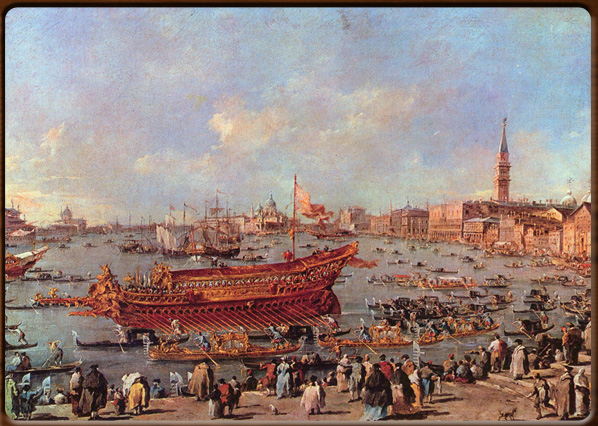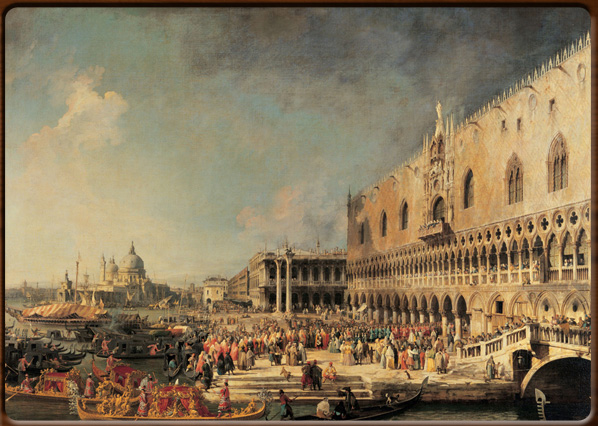
Departure of the Bucintoro to San Nicolò di Lido,1768, F. Guardi, Louvre

Solemn entry of the Earl of Gergy in Palazzo Ducale, Canaletto.


No video
Drawing on the beautiful plates designed by the painter Canaletto and carved in copper by the engraver Brustolon in 1766, now preserved in the Museo Correr, here is a description of the major solemn events and festivities involving the Doge of powerful and magnificent Venice.
Canaletto’s genius captured the scenes of feasts, depicting their every detail, from buildings to furniture, boats and clothes, plus their theatrical settings.
1 - Presentation of the Doge in St. Mark’s Basilica:
this is one of solemn ceremonies during the election of the Doge with a strong symbolic value. Inside the Basilica, the newly elected “Serenissimo” was shown and presented to the people by the eldest of the forty-one noble voters. The Doge swore to ensure peace, prosperity and justice for the Republic using ritual formulas.
2 - Transportation of the Doge in the “pozzetto” in St. Mark’s Square:
after his inaugural ceremony in the Basilica, the Doge got into the “pozzetto” and was carried triumphantly into the square by the “arsenalotti”. During the trip around the square, the Doge distributed gold and silver coins minted for the occasion to the happy crowds, while the Procuratie buildings were festively decorated with tapestries and drapes.
3 - Coronation of the Doge on the Scala dei Giganti:
the Doge was crowned in the main courtyard of the Doge’s Palace. Prior to 1485 this ceremony used to take place in the Chamber of the Senate, but was then moved outside, with the impressive background of the recently finished Scala dei Giganti. The Doge, made the “promissione”, swearing loyalty to the laws of the State, and received the “camauro”, a white canvas hood and the “zoia”.
4 - The Doge thanks the Greater Council: this was the Doge’s first speech to the Greater Council, the main legislative organ of the Venetian State, thus concluding the inaugural ceremonies. In the splendid hall of the Doge’s Palace where the Council met, the Doge thanked them for his successful election by lifting the Doge’s horn-shaped hat as a sign of recognition.
5 - Departure of the Doge on the Bucentaur for the Sposalizio col Mare ceremony:
one of the most important Doge’s feasts, after his inauguration, was the so-called Sposalizio col mare. The Doge set sail on the Bucentaur, the monumental ceremonial Venetian galley, accompanied by a procession of boats towards the island of Lido. Here, the Doge celebrated the rite of marriage by throwing a ring into the sea in memory of the departure of the victorious expedition in Dalmatia under Doge Pietro II Orseolo in the year 1000.
6 - The Doge on the Bucentaur at San Nicolò:
after the “Sposalizio col Mare” rite, the cortege headed towards the church of San Nicolò del Lido to attend a solemn mass. The church is dedicated to San Nicola, the patron saint of sailors, thus making him a very popular saint in Venice. After the religious function, the Doge and his large following returned to the city for a banquet in the Doge’s Palace.
7 - The Doge takes part in the “Giovedì Grasso” festivities:
this ancient festival, finally ratified in 1550, commemorates the victory in 1162 by the Doge Vitale Michiel II over the patriarch of Aquileia. In the 16th Century the great feast of “Giovedì Grasso” moved to St. Mark’s Square, where crowds filled the square and the Doge watched the performances from the loggia of the Doge’s Palace. The “Macchina”, a dramatic three-storey construction, was built for this occasion and used, among other things, for the repeated launching of fireworks. The “Labours of Hercules” were enacted under this (skilled acrobats forming human pyramids), as well as the “Moresca” military dance. The “Macchina” was also used for the “Volo dell’Angelo” (Flight of the Angel), later called the “Svolo del Turco” (Flight of the Turk), which involved a daring tightrope walker gliding on a rope hung between the bell-tower and the Doge’s Palace.
8 - Visit by the Doge to the Chiesa della Salute:
the Doge's visit to the church of Madonna della Salute was an annual event that first took place in November 1631, to commemorate Venice’s salvation from the terrible plague of 1630. The ritual involves a bridge of boats made by the faithful and survived the fall of the Republic, the people being particularly devoted to the Madonna.
9 - Procession of the Doge on the day of Corpus Christi:
Corpus Christi is a religious festival celebrated in Venice since 1295 (though only ratified by the Greater Council in 1454). Watched by the Doge and the faithful, a canopy bearing a monstrance and decorated with the insignia of the Scuole Grandi (master guilds). A masterpiece by Gentile Bellini, Procession in St. Mark’s Square (1496), now hangs in the Gallerie dell'Accademia, illustrates the event in great detail.
10 - Visit of the Doge to San Zaccaria on Easter Sunday:
another public appearance of the Doge in a place of worship. Each Easter Sunday, the Doge went in procession overland to San Zaccaria, the church where the noblest and richest Venetian maidens spent their religious novitiate. The reason for this occasion was perhaps due to a sort of patronage by the Doge for this ancient church, built in 827 by the Doge Giustiniano Particiaco.
11 - Reception of Ambassadors in front of the Doge in Collegio:
one of the most solemn of the Doge’s official duties was to receive foreign ambassadors, the nuncios and legates visiting the Republic with their delegations. The Collegio in the Doge’s Palace was used for this purpose, normally used for the meetings of a major Magistratura (Venetian authority).
12 – The Doge’s Banquet:
banquets in the Republic were matters of great pomp and ceremony and were part of the solemn secular duties of the Serenissima. The Doge invited the Ambassadors and the highest offices of State to banquets on several occasions, often coinciding with important religious feasts. From the 17th Century onwards, these receptions were held in the Sala dei Banchetti, built for this purpose by the Doge Antonio Priuli in a wing of the Doge’s Palace.
1600 - 1700 - - rev. 0.1.11